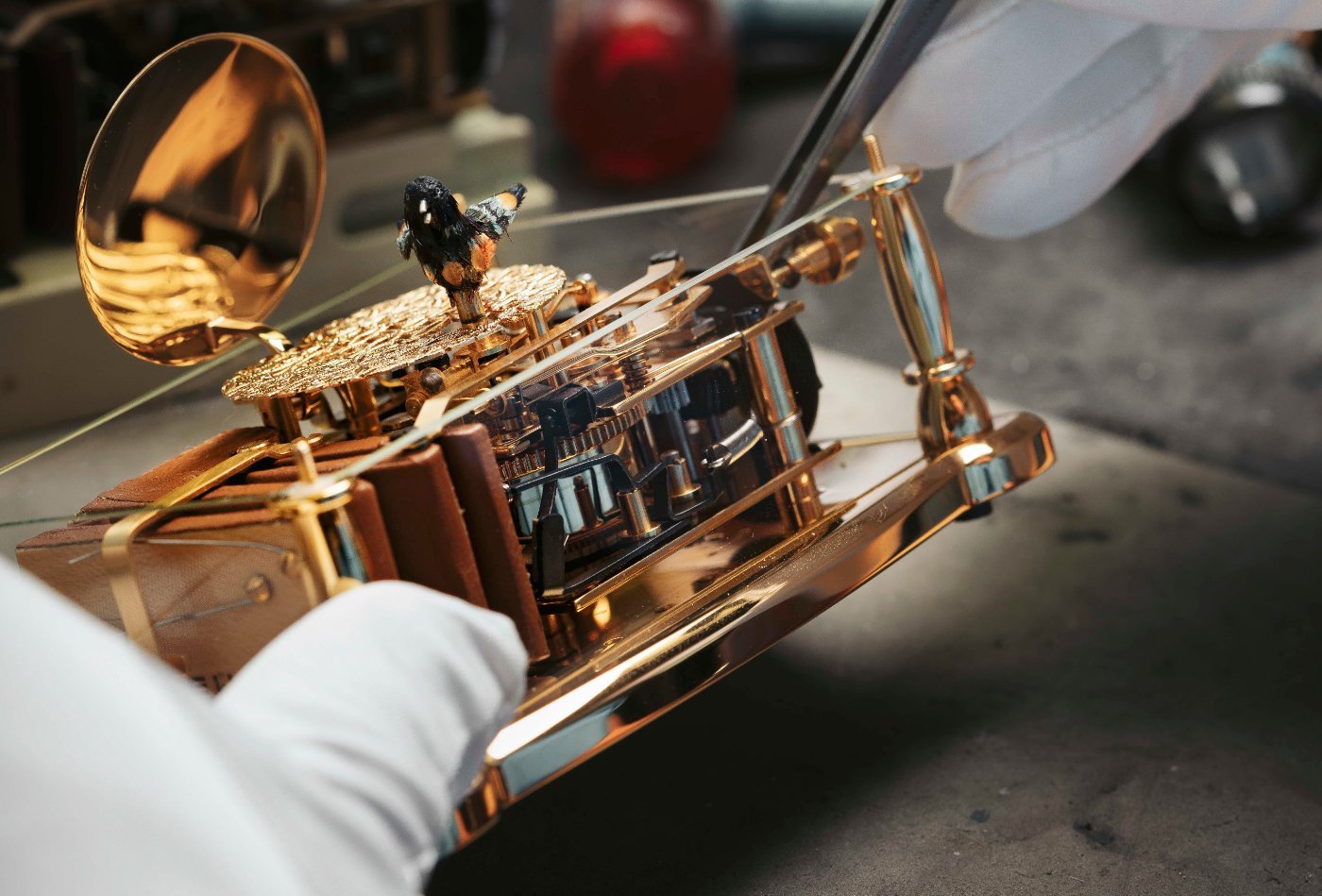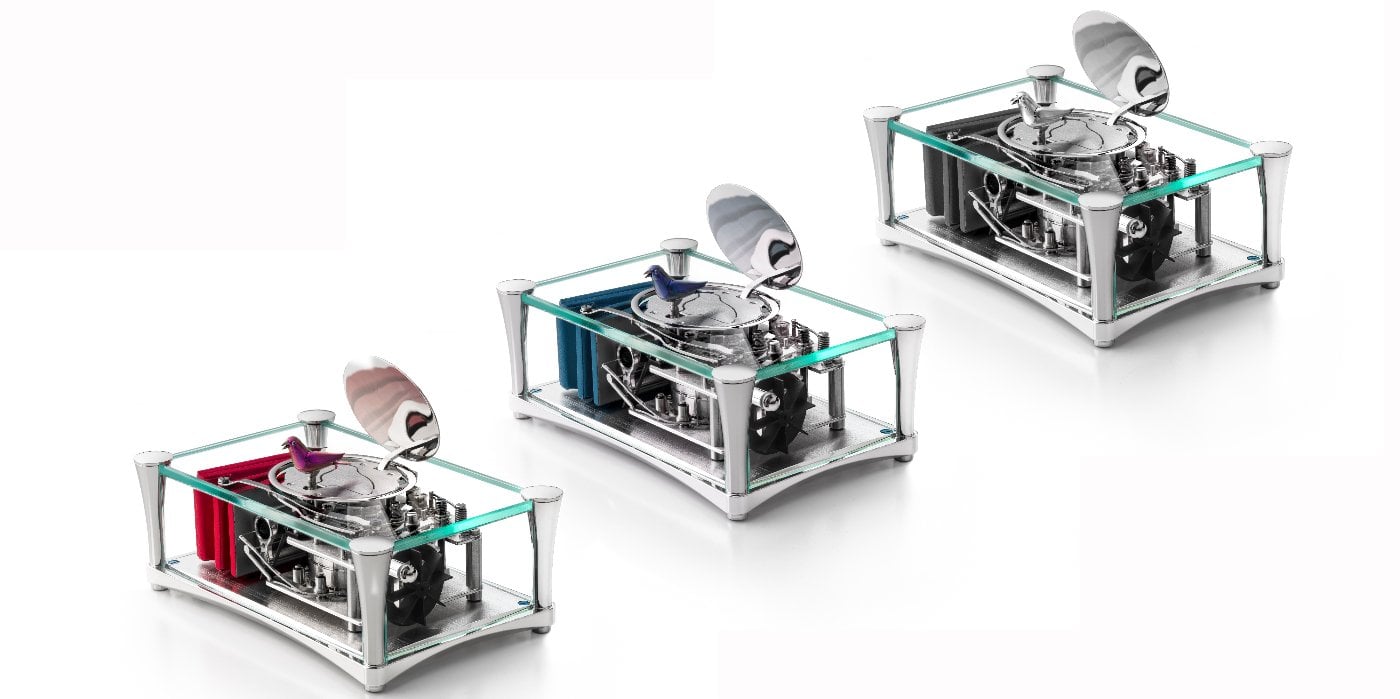orn in the 18th century, snuff boxes - called Tabatières in French - were a major, often bespoke personal and valuable possession. A rare few concealed a surprise behind their beautiful decorations: an automaton. A singing bird in nature is a fleeting spectacle, a momentary gift that invariably flies away, leaving the observer with the evanescent memory of beauty.
By creating a singing bird automaton rather than a captured bird in a cage, Reuge wishes to pay tribute to this natural and magical gift of nature. Upon activation of a lever, the colorful animal pops out of the automaton where it was hidden from view under an oval cover. It flaps its wings and moves every joint of its small body in unison with an enchanting tune imitating the song of a Green Canary to a fault. The spectacle is so authentic that it seems like a real bird.
Reuge demonstrates its inventiveness with its recent creation, the Green Canary, which is crowning the “Enchanting Birds’ line. It is meant as a tribute to an endangered bird. The Geen Canary owes its name to the color of its plumage. We tend to think of the canary as yellow, even though its original color is discreet, suitable for camouflage in wooded areas.

It is because the Spaniards discovered it in the 16th century that the yellow domesticated canary came about, the result of successive breeding selections according to the criteria of its color, its song, but also its posture. By returning to the first bird in the lineage, Reuge wishes to respect the splendor of its song and to honor its beauty and scarcity.
The bird’s tune stems from an extendible bellow in leather that is stored, much like an accordion pleat, by the mechanical movement’s side. The most important prerequisite is that the result be airtight. If it isn’t 100% impermeable, the bird’s song will turn into a whisper. On the other hand, the leather must be of unrivalled suppleness to allow the bellow to fold smoothly and without snagging.
The craftsman’s challenge is better understood when one considers the combination of these two constraints: complete airtightness applied to a 0.25 mm thin leather which guarantees its flexibility. Mastering this perilous balance requires a dexterity anchored in a tradition that very few craftsmen possess. The result is an organic sound of such purity, that with closed eyes, one could not tell the difference with an actual birdsong in nature. Reuge reproduces the melody and intonation of the green canary with virtuosity.

The motion is determined by an automaton enclosed in a transparent casing. Reuge respects the bird’s exact mimics, right down from pairing the opening of its beak, tilt of its queue and to the flapping of its wings. The bird of la Tabatière consists of more than 250 components working in perfect synergy. High precision Swiss machinery is used for the first manufacturing stage of the most critical mechanical components, when each micron makes a difference. In a second stage, they are assembled by hand in the brand’s Ateliers in Sainte-Croix.
The bird is entirely mechanical, can be dismantled and reassembled by the craftsman without losing any of its precision or beauty. The Tabatière’s lid can be disengaged, meaning that the bird retracts and stows away if someone should force the flap in the middle of the show. This mechanism is a safety device to prevent the movement from breaking in case of misuse, and it certainly brings an additional technical refinement to this masterpiece.
What’s more, it’s now possible to halt the whole movement and freeze the bird in mid-tune if one should wish to admire it more closely. The activation and halt, on demand, of all 250 components attests to the ingenuity and know-how of the Reuge artisans. To bring together so many complex motions and features under a single mechanical movement is an absolute feet of craftsmanship and innovation. But this is what it takes to approach nature’s complexity. The result – especially when the tune meets the motion – is absolutely unique.

Four choices of color pairing the bird with the leather bellows are available so as to suit any aspiration. Monochrome has pride of place in the steel black execution; the bright fuchsia and metallic blue versions give the collection a chromatic boost; finally, the latest Green Canary execution brings us closer still to the natural embodiment of a canary bird. All the birds are made of titanium for the body and wings and gold for the beak. To obtain a color gradient on the body of the bird, a craftsman dips this body part in successive stages in a galvanic bath.
The Tabatière and the bird are rose gold-plated which matches perfectly with the canary’s shades of green. The determination to add technicality to the heart of the craft drives Reuge in each creation. Honesty is a fundamental value for the brand thus choosing a full transparent casing so as in order to disclose the automaton movement in all its beauty. Upon activation, the observer notices the mechanical ingenuity generating the bird’s movement and can admire the gentle sway of the bellow conveying sound. Four conical columns delimit the Tabatière’s perimeter giving the object of art a streamlined, elegant look, fundamentals of Reuge’s aesthetics codes.










